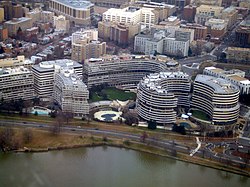| This article needs additional citations for verification. Please help improve this article by adding citations to reliable sources. Unsourced material may be challenged and removed. Find sources: "Committee for the Re-Election of the President" – news · newspapers · books · scholar · JSTOR (March 2009) (Learn how and when to remove this message) |
| Watergate scandal |
|---|
 The Watergate complex in 2006 The Watergate complex in 2006 |
| Events |
| List |
| People |
| Watergate burglars |
| Groups |
| CRP |
| White House |
| Judiciary |
| Journalists |
| Intelligence community |
| Congress |
Related
|
The Committee for the Re-election of the President (or the Committee to Re-elect the President, CRP, but often mocked by the acronym CREEP) was, officially, a fundraising organization of United States President Richard Nixon's 1972 re-election campaign during the Watergate scandal. In addition to fundraising, the organization also engaged in political sabotage against Nixon's opponents, the various Democratic politicians running in the election.
History
Planning began in late 1970 and an office opened in the spring of 1971. Besides its re-election activities, CRP employed money laundering and slush funds, and was involved in the Watergate scandal.
The CRP used $500,000 in funds raised to re-elect President Nixon to pay legal expenses for the five Watergate burglars. This act helped turn the burglary into an explosive political scandal. The burglars, as well as G. Gordon Liddy, E. Howard Hunt, John N. Mitchell, and other Nixon administration figures (Watergate Seven), were indicted over the break-in and their efforts to cover it up.
The acronym CREEP became popular due to the Watergate scandal.
Prominent members
- Charles Colson, special counsel to the President
- Kenneth H. Dahlberg, Midwest finance chairman; developer of the Miracle-Ear hearing aid
- Francis L. Dale, chairman; publisher of The Cincinnati Enquirer; owner of the Cincinnati Reds
- E. Howard Hunt, consultant to the White House; retired CIA operative
- Herbert W. Kalmbach, deputy finance chairman; President Nixon's personal attorney
- Fred LaRue, deputy director; aide to John Mitchell
- G. Gordon Liddy, finance counsel; former aide to John Ehrlichman
- Clark MacGregor, chairman
- Jeb Stuart Magruder, deputy director
- Fred Malek, manager, former Deputy Undersecretary of Health, Education, and Welfare
- James W. McCord, Jr., security coordinator; former director of security at the Central Intelligence Agency
- Judy Hoback Miller, bookkeeper
- John N. Mitchell, director; former United States Attorney General
- Donald Segretti, political operative
- DeVan L. Shumway, spokesman
- Hugh W. Sloan, Jr., treasurer; former aide to White House Chief of Staff H.R. Haldeman
- Maurice Stans, finance chairman; former United States Secretary of Commerce
- Roger Stone, political operative
See also
References
- Joan Hoff (2010). L. Edward Purcell (ed.). Richard Milhous Nixon. Vol. Vice Presidents: A Biographical Dictionary. Infobase Publishing. p. 351. ISBN 978-1-4381-3071-2.
- "Committee for the Re-Election of the President Collection: Frederic Malek Papers". Nixon Presidential Library & Museum. Archived from the original on 2010-05-31. Retrieved 2010-06-04.
- "Watergate scandal", Encyclopædia Britannica, by Rick Perlstein, June 10, 2019. Retrieved June 15, 2019.
- 100 Mistakes that Changed History: Backfires and Blunders That Collapsed Empires, Crashed Economies, and Altered the Course of Our World, by Bill Fawcett, Penguin, October 5, 2010, page 289. Retrieved June 15, 2019.